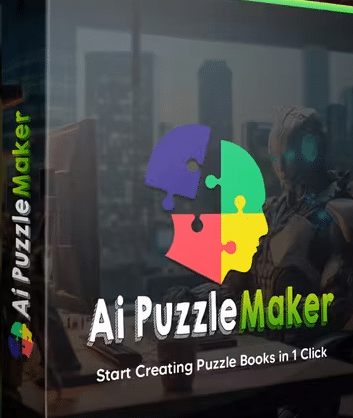AI PUZZLE MAKER OTO links 1st, 2nd, 3rd, 4th, 5 Versionsto the direct sales pages. With the big discount and three hot Bonuses packages. see all the AI PUZZLE MAKER OTO sales pages below, with all info for each OTOs
AI PUZZLE MAKER OTO Links + Three Hot Bonuses Below
Note: Buy Front-End before OTOs to work well. you can buy FE or OTOs from the Locked link below 
Use this free coupon ==> ” AIPUZZLE5 “
>> Front-End <<
>> OTO1 Unlimited Edition <<
>> OTO2 DFY Edition <<
>> OTO3 Automation Edition <<
>> OTO4 Profit Sites Edition <<
>> OTO5 Reseller Edition <<
>> OTO6 Agency Edition <<
>> OTO7 WhiteLabel Edition <<
Your Free Hot Bonuses Packages
>> Hot Bonuses Package #1 <<
>> Hot Bonuses Package #2 <<
>> Hot Bonuses Package #3 <<
Creating a narrative or story arc within your puzzle book can add an extra layer of intrigue and engagement for your readers. By incorporating a storyline that unfolds as they solve the puzzles, you can guide them through a captivating journey. Consider developing characters, settings, and a plot that connects each puzzle and provides a sense of progression. As readers work their way through the book, they will not only exercise their problem-solving skills but also become invested in the unfolding narrative. With careful planning and integration, your puzzle book can become a compelling adventure that keeps readers coming back for more.
Introduction Ai Puzzle Maker OTO
Creating a narrative or story arc within a puzzle book can add depth and engagement to the overall experience for readers. It allows them to not only solve puzzles but also become immersed in a compelling storyline. In this article, we will explore various strategies and tips to help you create a narrative or story arc that will captivate your audience and make your puzzle book truly memorable.
Understanding the Importance of a Narrative
A narrative or story arc serves as the backbone of your puzzle book, tying together the individual puzzles and providing a cohesive experience for the reader. It creates a sense of progression and purpose, making the solving journey more rewarding. Additionally, a well-crafted narrative can set the tone, establish a unique atmosphere, and create emotional connections with the readers.
Choosing the Right Narrative Structure
There are various narrative structures you can consider when designing your puzzle book. Here are a few popular options:
Linear Narrative
A linear narrative follows a chronological sequence of events, guiding readers through a predetermined path. This structure is straightforward and provides a clear sense of progression. It is suitable for beginners or for puzzle books aimed at younger readers who may prefer a more guided experience.
Nonlinear Narrative
In contrast to a linear narrative, a nonlinear narrative presents the events out of chronological order. This structure can add mystery and intrigue to your puzzle book, as readers piece together the story fragments in a non-linear fashion. It offers a higher level of challenge and is well-suited for more experienced puzzle solvers.
Branching Narrative
A branching narrative allows readers to make choices that impact the direction of the story. This structure adds an interactive element to your puzzle book, giving readers agency and allowing for multiple paths and endings. It can be especially engaging for readers who enjoy a more personalized and exploratory experience.
Developing Characters and World-building
To enrich your puzzle book’s narrative, it is essential to develop memorable characters and a well-crafted world. Consider the following:
Character Development
Create characters that resonate with your audience and add depth to the story. Develop their personalities, motivations, and relationships. You can introduce characters through puzzles, clues, or even illustrations. As readers progress through the puzzles, they can uncover more about the characters and their role in the story.
World-building
Crafting a rich and immersive world can enhance the narrative experience. Consider the setting, the rules of the world, and any unique elements that make it distinct. Add details and descriptions throughout the puzzles or accompanying text to give readers a sense of place and help them connect with the story on a deeper level.
Incorporating Puzzles into the Narrative
Puzzles should not feel like separate entities but rather seamlessly integrate into the narrative. Here are some strategies to achieve this:
Puzzle Types and Themes
Choose puzzle types that align with the narrative and enhance its elements. For example, if your puzzle book is set in a magical world, incorporate puzzles that require spellcasting or decoding magical symbols. Tailor the themes and mechanics of the puzzles to match the story’s tone and atmosphere.
Puzzle Progression
Design the puzzle progression to mirror the story arc. Start with simpler puzzles that gradually increase in complexity, reflecting the rising action of the narrative. This progression keeps readers engaged and motivated to uncover the next piece of the story while challenging their puzzle-solving skills.
Puzzle Integration
Integrate puzzles into the narrative by making them relevant to the plot or character development. For instance, a puzzle could reveal a crucial clue or unlock a new area in the story. This integration makes puzzles feel like natural components of the narrative instead of arbitrary obstacles.
Maintaining Consistency and Balancing Difficulty
Consistency is crucial when combining puzzles and narrative. Consider the following:
Tone and Style
Ensure that the tone and style of the puzzles align with the narrative. For example, if your puzzle book has a lighthearted and whimsical narrative, the puzzles should reflect that through colorful illustrations and playful challenges. Consistency in tone helps readers stay immersed in the story and creates a seamless experience.
Difficulty Levels
Balance the difficulty levels of the puzzles to cater to a broad audience. Include puzzles that range from easy to challenging to accommodate different skill levels. Gradually increase the complexity as readers progress through the story, providing a sense of accomplishment and encouragement for those who may be less experienced in puzzle-solving.
Conclusion
Creating a narrative or story arc within your puzzle book can elevate the overall experience for readers, turning it into a captivating adventure. By choosing the right narrative structure, developing characters and world-building, seamlessly incorporating puzzles, and maintaining consistency, you can create a puzzle book that not only challenges but also delights and engages readers on a deeper level. Embrace your creativity, strike a balance between accessibility and innovation, and let your puzzle book stand out in the crowded market. Happy puzzling!
Your Free Hot Bonuses Packages
>> Hot Bonuses Package #1 <<
>> Hot Bonuses Package #2 <<
>> Hot Bonuses Package #3 <<
<<<=== All The Bonuses Above ===>>>
Table of Contents


